- Home Page
- Better Kites
- ... Diamond Kite
How to Make a Diamond Kite
Step by Step—Page 2 of 3
The MBK 1-Skewer Diamond
How to Make a Diamond Kite
Spars
For this diamond, you need two 30 cm (12 in.) bamboo BBQ skewers. The photo shows them laid over the sail before being snipped to length with scissors.
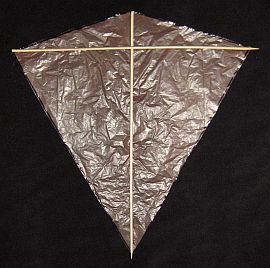
- Lay down a skewer over the center crease of the plastic, lining up the non-pointy end with the top corner of the plastic. Snip off the pointed end so the skewer lines up with the bottom corner of the plastic as well. This is the vertical spar.
- Lay down another skewer across the left and right corners of the sail, and again snip to length, removing the point. Also, make an easily seen mark on the skewer at the exact center point. This is the horizontal spar.
- Using a sharp corner, perhaps a blade of the scissors, make an indent in the bamboo at the center point you marked.
How to Make a Diamond Kite
Attaching Sail
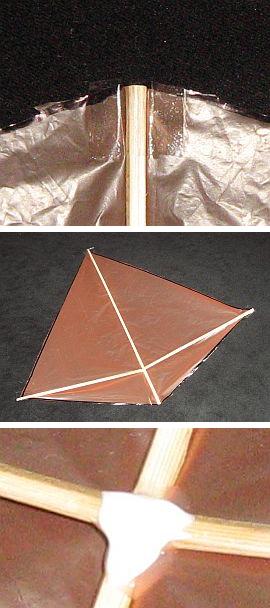
- Lay down the vertical spar skewer over the sail, and wrap a short length of clear sticking tape around each tip, securing them to the top and bottom corners of the sail. The top photo shows the top tip in closeup.
- Lay down the horizontal spar skewer, and attach its tips to the left and right corners of the sail in the same way.
- Bend the horizontal spar in the middle until it starts to crack at the indent! Carefully increase the bend until you can get the kite looking like the one in the middle photo. If you want to be precise, each wingtip is 0.13 SL (3.7 cm, 1 1/2 in.) off the tabletop.
- Dribble some wood glue all around where the skewers cross each other. See the bottom photo.
Wait for the glue to dry. Maybe start another one of these kites so you can fly them together in a train later on!
How to Make a Diamond Kite
Bridle
Dacron line 20- to 50-pound strength is suitable for all the Skewer Series kites.
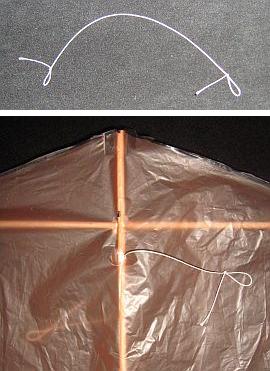
- Cut off some Dacron line to a length of 1.0 SL (29 cm, 11 1/2 in.), and tie a very small Loop knot into each end. See the top photo.
- Poke a hole in the plastic sail, 0.22 SL (6.4 cm, 2 1/2 in.) from the top tip of the vertical spar.
- Tie the middle of the line to the vertical spar with a simple Granny knot. Poke one end through the hole in the sail, and leave the other end hanging. See the bottom photo.
- Secure the knot onto the bamboo of the vertical spar with a tiny blob of wood glue so it can't shift up or down the spar.
How to Make a Diamond Kite
Tail
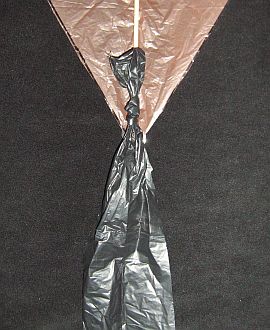
- Cut out a long thin rectangle of colored plastic for the tail. Mine is black to contrast with the orange sail. Make it 8.0 SL (230 cm, 90 in.) long and 0.2 SL (5.8 cm, 2 1/4 in.) wide. Knot pieces together, if necessary, to get the full length. Avoid taping, because it adds weight!
- Tie one end around the vertical spar as close as possible to the bottom tip. See the photo. A single Half Hitch will do, since there are very low forces on the tail in flight.
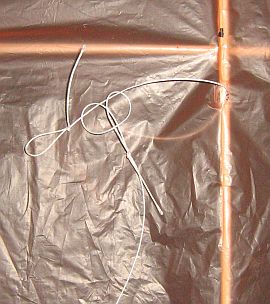
At this point, you've finished making the 1-Skewer Diamond!
To attach the flying line, just Lark's Head the flying line to the short kite line as in the photo.
Now for the cool bit: If you have made two or more kites, each attached to their own flying line, you can hitch them together in a train. Just put a fair-sized Loop knot into both ends of each flying line, and then it's easy to attach and unattach the kites. My first two diamonds flew great with a 10 meter (35 foot) line between them.
As mentioned earlier, there's more kite making on this site than you can poke a stick at. :-)
Want to know the most convenient way of using it all?
The Big MBK E-book Bundle is a collection of downloads—printable PDF files which provide step-by-step instructions for many kites large and small.
That's every kite in every MBK series.
